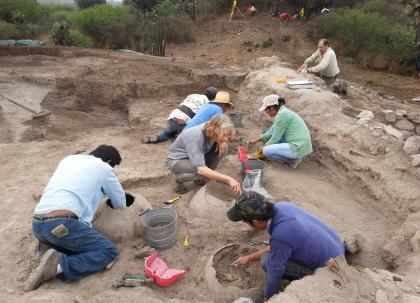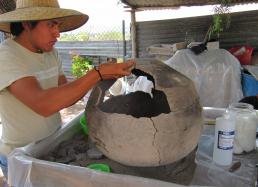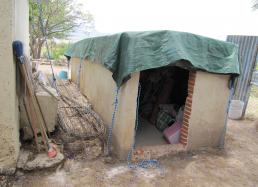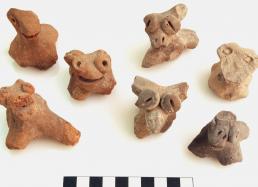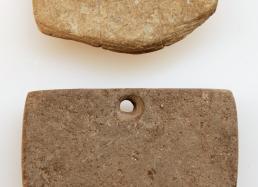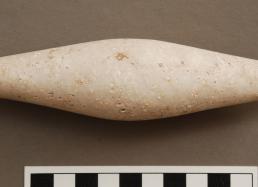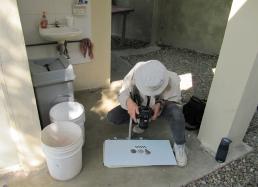7: Wait Till Next Year
With the loss of time, and the late start to our fieldwork this season, neither Linda nor I were really ready to curtail this season’s efforts in the field yet. We documented that two of the exterior corners of Mound 165 were rounded, which is rather rare for Oaxaca, but we’d yet to fully document the two other corners. In the last days, we found an exterior altar, or offering box, that was built for the fourth occupation down (what we're referring to as Surface 4) and then covered over for the surface above (Surface 3). What was that all about?
These questions and others both bothered and intrigued us. But while our hearts were still in the field, our heads saw the mounting lab work that remains to be tackled before we depart for Chicago. So we decided that the old baseball slogan, “wait till next year,” was also appropriate for archaeology.
The weather figures into these equations as well. Generally, we like to transition from the field to the lab in eastern Tlacolula (Valley of Oaxaca) before May 20th, to avoid the highest probability of daily or regular rains. This year, we continued about a week longer, and the truth is that we were very fortunate to have only a short and moderate morning downpour on our last day of fieldwork (see above image). Frankly, it could’ve been a lot worse. But if we needed any further sign that it was time to head to the lab, this was it.
In addition, we’ve been lightly rained on several afternoons while doing lab work. But also during this period, we've been drenched by heavy rain at least three times at night, and such downpours would have had a damaging effect on the excavations had they been still been in progress.
Overall, lab space at Lambityeco is a bit cramped, but it really has been a great deal of fun. We’ve had the chance to interact regularly with many INAH employees who also are employed at the site. Thanks to the leader of the Lambityeco site team, Carmen Elena Villa Durón (as well as the archaeologists and officials above her), the INAH employees have given us a lot of help, reconstructing the giant jars that we found and that were associated with prehispanic salt production (see Photo #1 below.) They’ve also helped put together several broken vessels that we found and assisted us with backfilling the excavation pit that we exposed. Backfilling will help preserve the area for future excavations, as well as for the planned consolidation of the complex for tourism at an even later date.
We’ve also been aided greatly by INAH’s decision to turn a cistern for water at the site into a temporary storage area for our collections and some of their tools (see Photo #2 below.) This ingenious and brilliantly timed move created much needed work space for the various areas of analysis now underway.
In part, we needed this space because of the well-timed arrivals of two of our long-time fieldwork collaborators, Dr. Heather Lapham from Southern Illinois University, who has studied animal bone for years (at El Palmillo, the Mitla Fortress, and now Lambityeco) and Lacey Carpenter, a graduate student from the University Michigan, who has collaborated with us in the field and lab for a number of years. Lacey also was the first author of a paper that recently was published on the spindle whorls recovered at El Palmillo.
We’ve also contracted two local architects, Oscar and Job, to assist Jessica with the mountains of illustrations that have yet to be done. Although few of the figurines that we found in the Mound 165 excavation are complete, and many are very partial, with the more than 800 figurines recovered there is a great amount of scientific illustration to accomplish in a relatively short time (see Photo #3 below.)
In addition to the analysis of bone and scientific illustration, there are kilos of pottery, as well as stone and shell artifacts, to examine. One of the things that I confirmed during the pottery analysis is that a fair quantity of the figurines may have been part of larger effigy whistles or ocarinas. Not only did we recover the effigies from these larger objects (unfortunately we have no complete pieces), but in our sherd collections, there also are many pieces and fragments that were part of the rest of these instruments. The abundance of whistles may have had a connection to the nearby temple and the rituals conducted there mentioned in a previous dispatch.
The 2013 stone artifact assemblage includes two rectangular pendants made of local stone (see Photo #4 below.) We've recovered pendants (sometimes made of ceramic, although stone is more typical) similar to these in Late Classic contexts now at three sites, El Palmillo, the Mitla Fortress, and Lambityeco. Yet as far as we know, these pendants haven't been reported elsewhere. Anyone familiar with these artifacts, please email me.
Another unusual find in the stone assemblage is a tapered pestle made of onyx, tecali, or a similar non-local stone that clearly was used to grind or delicately abrade (see Photo #5 below.) Over the last decade or so, we’ve looked at a great deal of Late Classic era stone, but have never found a comparable object.
Of course, as the material analysis moves forward, so too does photographic documentation. And, for that, Linda has had to squeeze herself between the sink and the bathroom in an attempt to ensure just the right amount of light (see Photo #6 below). Nevertheless, she's making this improvised set-up work, even though on some days we’ve had to move the camera set-up as the clouds and the light shifts. Several of the photos included with this dispatch are among the results, evidence that she's meeting this challenge.
Although there remains much to do, our team members all are working hard, and, despite the narrow temporal window that we have left, it looks like we can collectively complete what needs to get done while we're here. One thing is clear, we're learning something new every day, and for Linda and I at least, that only reinforces the mantra, “just wait till next year.”
More soon,
Gary

